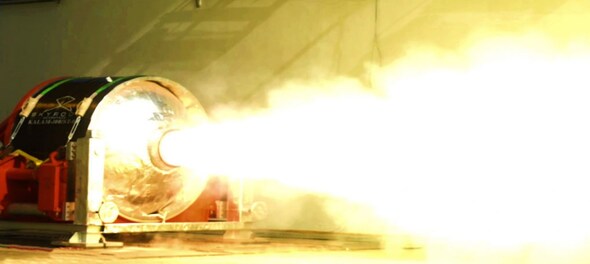
Hyderabad-based start-up Skyroot Aerospace has successfully completed the full duration test-firing of its Vikram-1 rocket stage. Vikram-1 is India’s first-ever privately designed and developed rocket for commercial missions. With the successful test-firing of the Vikram-1 rocket stage, the company is on track to launch its first full rocket.
Vikram-1 has three solid fuel-powered stages. Each stage has a burn time ranging between 80 and 108 seconds. The third stage of Vikram-1 has been named ‘Kalam-100’ after renowned Indian rocket scientist and former president Dr APJ Abdul Kalam. It produces a peak vacuum thrust of 100 kN (or ~10Tons) and has a burn time of 108 seconds, according to a statement released by the company.
Pawan Kumar Chandana, co-founder and CEO of Skyroot, said, “Full duration stage level testing is a major milestone for the development of our flagship orbital vehicle Vikram-1. The stage has delivered excellent performance and this success gives great confidence for our other rocket stages planned to be tested soon.”
We’re fired up to announce our successful completion of full duration static fire test of Vikram-1 rocket stage ‘Kalam-100’.
Peak Thrust: ~10TonsCarbon Fiber BuiltBurn time: 108sWitness the roar in our firing footage: https://t.co/3DhKB8O2nj 🔥🔥#MadeInIndia pic.twitter.com/hzfLg7p2wB— Skyroot Aerospace (@SkyrootA) May 19, 2022
Meanwhile, Manish Nuwal, MD and CEO of Solar Industries India Limited and investor in Skyroot Aerospace, said, “This is the largest rocket stage ever designed, manufactured, and tested completely in the Indian private sector.”
Last year, Skyroot Aerospace successfully test-fired its first solid rocket propulsion stage demonstrator called Kalam-5. The company claims that Kalam-5 is not just cost-effective but is also highly reliable with fewer moving parts. Additionally, it can handle "the pressure of 66 atmospheres and temperatures of up to 30,000 degrees Celsius".
(Edited by : Sudarsanan Mani)
First Published: May 19, 2022 11:17 AM IST
Check out our in-depth Market Coverage, Business News & get real-time Stock Market Updates on CNBC-TV18. Also, Watch our channels CNBC-TV18, CNBC Awaaz and CNBC Bajar Live on-the-go!


Lok Sabha Election 2024: What rural Delhi wants
May 16, 2024 10:10 PM
Over 50 onion farmers detained in Nashik ahead of PM Modi's visit
May 16, 2024 11:14 AM
Why Google CEO is cautiously optimistic about the election year
May 16, 2024 9:51 AM
Mark Mobius reveals how markets will react if NDA wins 400+ Lok Sabha seats
May 15, 2024 8:09 PM

